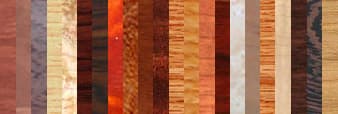Is it good design?
This is perhaps the hardest area to evaluate but here are some questions to ask yourself:
• Is the piece aesthetically pleasing to me?
• Does it have a sense of balanced proportion?
• Can you see influences of classic designs?
• Does it provide the function I need?
• Could it work in a different room or house if I move?
What is the wood?
Most furniture is built of wood. Different woods have different properties. Knowing about woods can help you evaluate furniture. Below are some of the woods Sawbridge’s craftsmen use most often.

Is It Well Constructed?
Quality construction often sets good furniture apart from great furniture that will last for generations. It is not always easy to spot the differences? Here are some simple “quick checks”?”
- How is the back finished? It is real wood or just a pressboard?
- How are the drawers constructed? Do they have dovetails at the corners? Are they paneled on the bottom to allow expansion and contraction of the wood? Do they slide without dragging?
- Do the doors line up evenly with the frame? Are they flush with the surface both at the top and the bottom?
- Are the crosspieces between drawers dovetailed or rabbetted into the vertical supports?
- Do the chairs have pegging at the joints or do they rely on metal brackets and glue to carry the weight?
- It the piece made of solid wood or high-quality ply with good veneers or pressboard with thin veneers?
- Is the tabletop made of fewer, wider planks or many thin boards glued together?
- Are grain patterns well matched and rhythmic or somewhat random?
- Is the finish applied evenly?
Understanding the construction and finishing of a piece can be fascinating but a somewhat technical. Click here for a brief glossary for some construction and finishing terms.
How Is It Finished?
A well-applied finish can bring a piece to life. There seems to be an infinite number of finishes available today. Understanding which one is best for you is important. Generally, finishes fall into one of two types: natural and hard.
Natural Finishes
A number of different types of finishes belong to “natural” classification including lemon oil, Danish oil, paste wax, etc. Most often the finish is the result of many applications of oil, such as boiled linseed, which soak into the wood. A natural finish is often completed with a coat of paste wax. Natural finishes are resistant to water and alcohol spills but a stain can result if the liquid is left standing. Scratches can easily be erased by applying paste wax with “0000” steel wool. Natural finishes achieve a beautiful patina over time.
Hard Finishes
A number of different types of finishes including, varnish, polyurethane, and catalyzed lacquer belong to this classification. These finishes are generally impervious to water and alcohol. Once the finish is scratched, however, the only remedy is to disguise the scratch with wax or have a professional “spot lacquer” it. A beautiful gloss can be achieved with a lacquer finish although lower gloss levels show fewer scratches.
